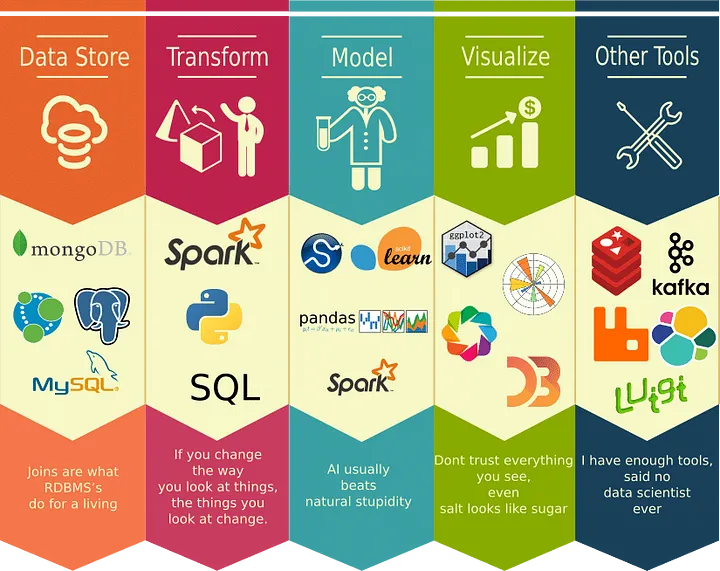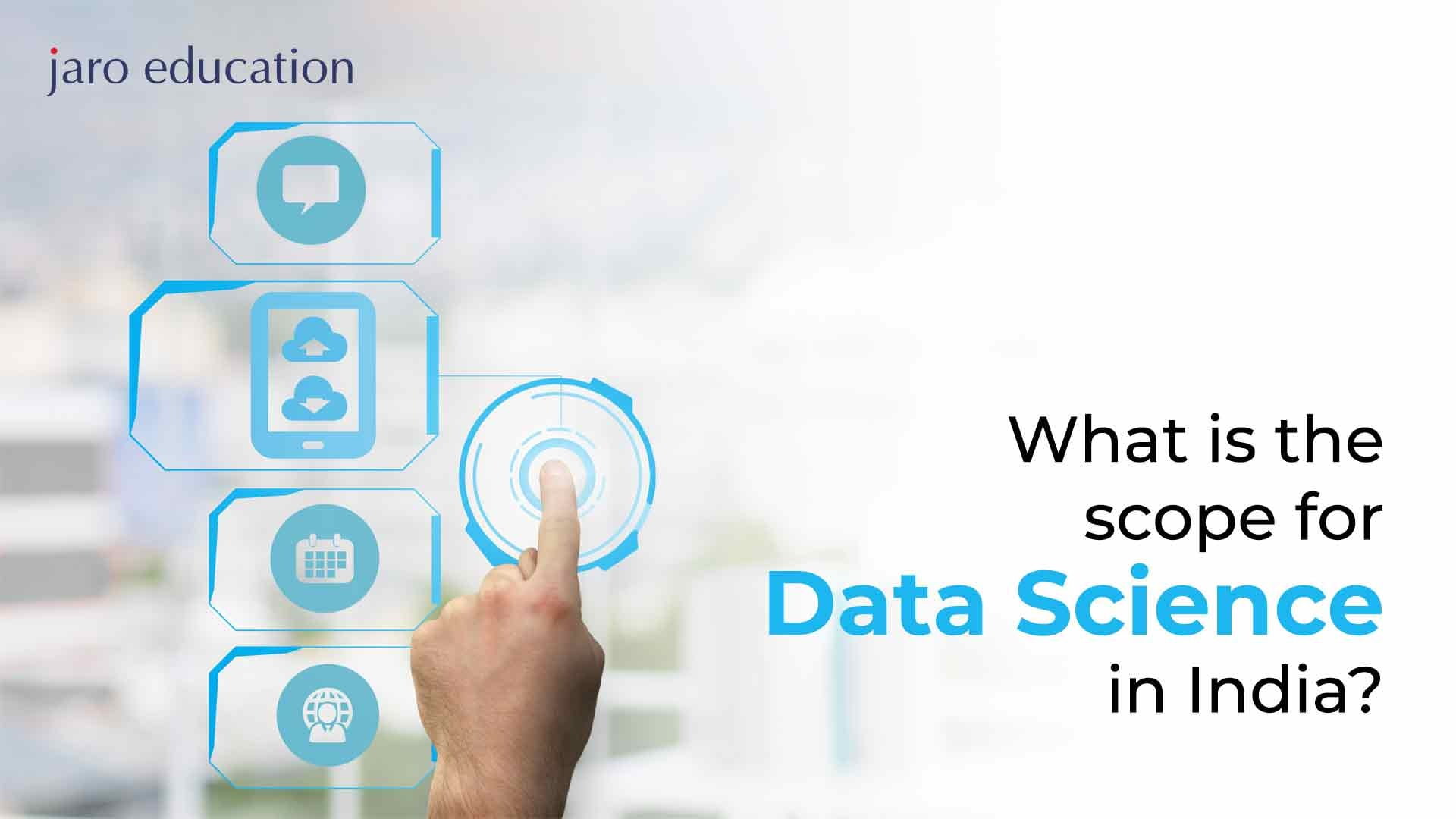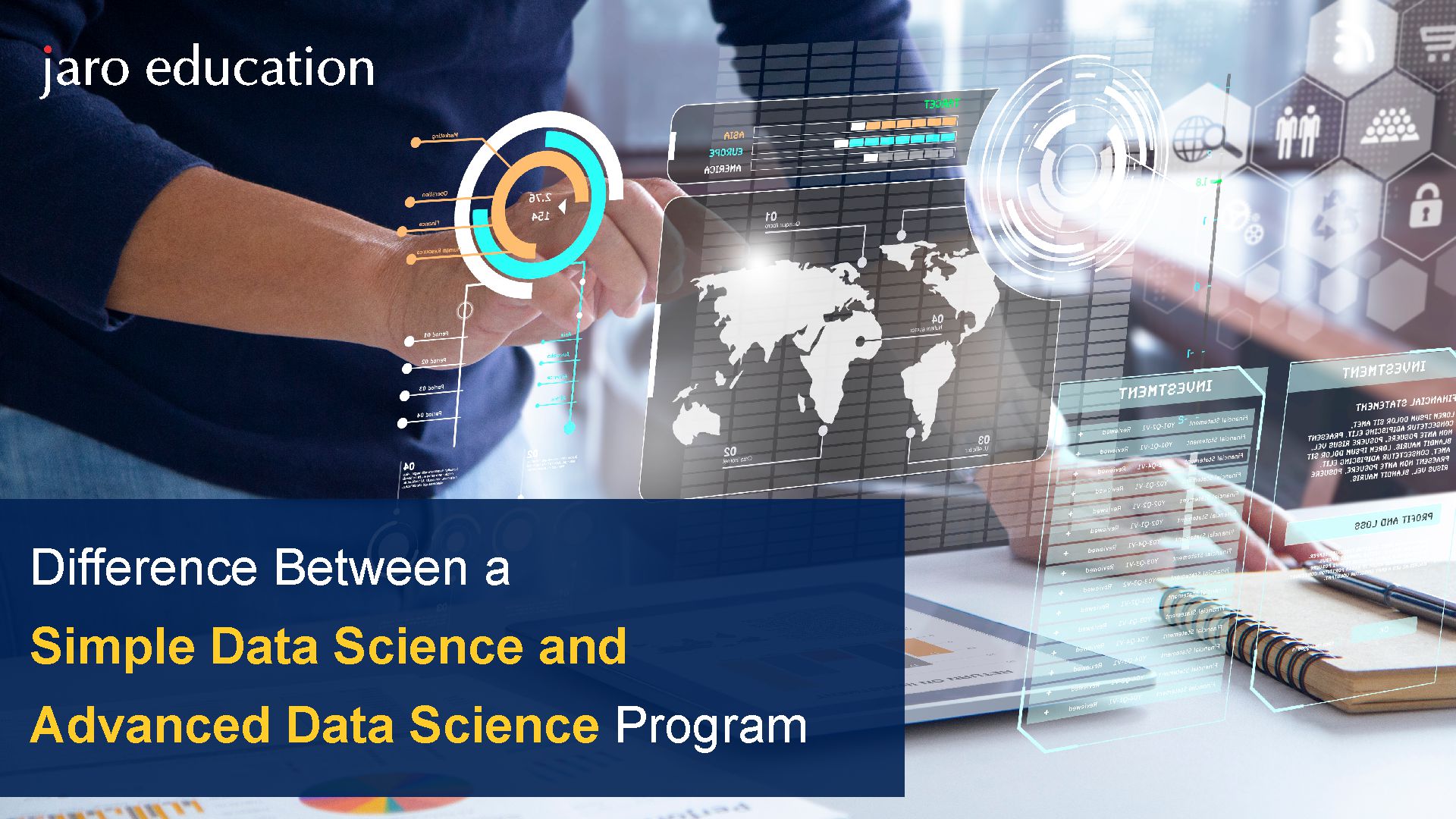
- jaro education
- 21, February 2024
- 10:00 am
The demand for data science skills continues rising as organizations increasingly realize the value of extracting insights from data to guide strategy. However, becoming an expert data scientist requires moving beyond textbook concepts to gain hands-on experience through real-world projects. This blog provides a comprehensive guide to data science project ideas tailored for beginners and experienced professionals.
Basics of Data Science
Mastering the fundamentals, including data types, quantitative methods, programming languages, and modeling, lays the groundwork for data science mastery. Let’s understand them better.
Data Types and Wrangling
Grasping the fundamental concepts in data science is vital before applying them to projects. Core ideas that beginners should comprehend include types of data, basic quantitative methods, popular programming tools, general machine learning workflow and evaluation metrics.
Table of Contents
Data science leverages both structured and unstructured data. Structured data includes tabular formats like spreadsheets and SQL databases with predefined fields. On the other hand, unstructured data encompasses images, texts, audio, and videos without confirming formats. Methods to wrangle different data types should be understood.
Mathematical Foundation
Quantitative methods form the mathematical foundation. Descriptive statistics, data visualization, correlation, and statistical testing are crucial for initial data analysis. Probability, algorithms, and optimization techniques enable the building of ML models. Linear algebra and multivariable calculus power advanced analytics.
Tools and Languages
Python has become the most popular programming language for data science. Core libraries like NumPy, Pandas, and Matplotlib and machine learning frameworks like Scikit-Learn and TensorFlow should be learned. Other languages like R and tools like SQL, Hadoop, and Spark have specific utilities for analytics tasks.
Model Building and Evaluation
The standard machine learning workflow involves data collection, cleaning, and feature engineering, followed by choosing a suitable model, training/testing and performance evaluation. Algorithms for supervised learning, like regression and classification, and unsupervised learning, like clustering and dimensionality reduction, should be tested across projects to understand their working and appropriate applications.
Data Science Project - Selection Criteria
Selecting the right projects is key to improving data science skills. Beginners should focus on developing core abilities like data preparation, visualization, and basic machine learning models. Exploratory analysis, classification systems, and recommendation engines allow hands-on practice of end-to-end techniques while aligning with interests.
Experienced professionals should choose advanced projects that demonstrate specialized skills. Data engineers can work on large-scale pipeline solutions. Machine learning experts can implement complex deep learning for natural language or image analysis. Picking projects within their focus areas allows experts to grow niche expertise.
Project Ideas in Data Science For Beginners
Hands-on projects help beginners gain data science skills for their portfolios. They can choose the best data science projects that match their interests while learning data cleaning, analysis, visualization, machine learning and more. Beginner project ideas include:
1. Exploratory Data Analysis
A key skill for data scientists is the ability to analyze and extract insights from any new dataset. A great project involves loading a dataset, inspecting it for missing values and anomalies, cleaning the data, summarising key attributes, and visualizing variables through plots to find patterns. Useful Python libraries include NumPy, Pandas, Matplotlib and Seaborn. Exploratory analysis is crucial for understanding the data before applying ML algorithms.
2. Customer Churn Prediction
Customer churn modeling uses classification techniques to identify customers likely to cancel a subscription. Using a sample churn dataset from Kaggle containing customer attributes, you can preprocess the data and train logistic regression, decision trees or random forest models. Evaluate models with a confusion matrix, classification reports, ROC curves and precision-recall values. The end goal is to predict customers who may churn and take action to retain them.
3. Movie Recommender System
Recommender systems suggest relevant products using correlation techniques or content filtering on sample data. A movie recommender using Python libraries like Pandas and Scikit-Learn can apply correlation between users/movies to make personalized suggestions. Alternatively, natural language processing on plot summaries and metadata can also filter and recommend movies with similar content.
4. Fake News Classifier
Fake news spreads false information framed as legitimate news. Using NLP and ML on satire/scam datasets, you can build models to identify fake news articles. Extract text data and engineered features to train classifiers like logistic regression, naive Bayes, and SVM using Python’s NLTK, SpaCy, and Scikit-Learn. Evaluation metrics include accuracy, precision, and recall. Deploying these models can help mitigate the spread of misinformation.
5. Stock Price Prediction
Applying time series analysis to historical stock data can forecast future direction and prices. Using Python libraries like NumPy, Pandas, and Matplotlib, analyze the time series data, preprocess it, and extract features. Then train ARIMA, Prophet models or LSTM neural networks to make stock price predictions. Evaluation involves metrics like MAE, MSE and directional accuracy. This has applications in algorithmic trading strategies and investment decisions.
6. Image Recognition with Convolutional Neural Networks
Image classification is a common computer vision task. Convolutional neural networks (CNNs) are especially effective for identifying and labeling objects in images. Beginners can use Python along with frameworks like TensorFlow and Keras to train CNN models. Some good image datasets to practice on are MNIST (handwritten digits), CIFAR-10 (10 categories of objects) and ImageNet.
7. Chatbot for Customer Service
Chatbots leverages machine learning to provide customer support automatically at scale. Beginner data scientists can train sequence-to-sequence recurrent neural network models like LSTMs on datasets of customer queries mapped to responses. This allows the chatbot to learn response generation based on question patterns. Python libraries like NLTK and spaCy can preprocess text data for model input.
8. Sentiment Analysis with Machine Learning
Sentiment analysis aims to computationally detect if a text expresses positive, negative or neutral opinions. For instance, reviews of products can be algorithmically classified as conveying satisfaction or disappointment. Using a dataset of customer reviews, Python’s machine learning stack Scikit-Learn can build classifiers like logistic regression and Support Vector Machines (SVM) after the text data is cleaned, tokenized and vectorized with Python’s NLTK library.
9. Predictive Maintenance
Critical equipment like engines need regular upkeep before failure to minimize downtime. Historical time series data from sensors can be used to predict maintenance needs even before errors emerge. Data preprocessing followed by time series forecasting models in Python like ARIMA and Prophet can uncover trends and seasonal failure patterns to schedule proactive upkeep.
10. Customer Segmentation
Customer segmentation uses clustering algorithms like K-Means to group customers into categories based on attributes like demographics and purchasing behavior from sample datasets. This provides customized marketing and product recommendations for segmented groups and the evaluation uses silhouette analysis and Elbow plots.
11. Music Recommendation Engine
Music recommenders suggest songs based on a user’s listening history and audio features of songs. Collaborative filtering analyses listening patterns, while content-based filtering uses audio features extracted from Python libraries like Librosa. Recommendation quality is measured by mean average precision and recall. This can be used to create personalized playlists.
12. Fraud Detection
Fraud detection aims to identify anomalies and irregular patterns in transactions that may indicate fraudulent activity. Fraud can be detected using outlier detection and cluster analysis techniques on sample datasets. This helps financial institutions recognize fraud early.
13. Bike Rental Demand Forecasting
Historical bike rental demand can be modeled with time series techniques to forecast future demand. Data preprocessing followed by SARIMA and FB Prophet models using Python can predict bike rental patterns. This rental demand prediction helps optimize inventory.
14. Text Summarisation
Text summarisation generates a concise summary while preserving key information and context. Using Python’s NLTK and Gensim, important sentences can be ranked algorithmically from text corpus based on frequency, position and similarity. Abstractive techniques using seq2seq models also generate new summaries.
15. Web Scraping and Analysis
Important data can be extracted from websites through web scraping using Python libraries like Beautiful Soup. Scraped data when cleaned and analyzed using Pandas, Matplotlib provides valuable insights. On the other hand, real-world web analytics enhances business intelligence.
As beginners complete end-to-end projects across these domains, they gain valuable hands-on data science skills and experience.

*miro.medium.com
Data Science Project Ideas For Experts
Advanced data science project ideas for experienced data professionals include:
1. Predicting Car Resale Value
Forecasting used car prices helps buyers and sellers. Collecting car make, model, year, mileage, location, etc., and applying regression models like random forest, and XGBoost using Python/R can predict resale value. With that, advanced ensembling can improve predictions and deploying this as a web app guides pricing decisions.
2. Conversational AI Chatbot
Building production-ready conversational chatbots requires speech recognition and deep learning for natural language processing. Python libraries like Tensorflow, Keras and PyTorch can train neural networks on conversational data. Deploying the chatbot with streamlined voice and dialogue capabilities improves customer experience.
3. Object Detection in Images
Object detection identifies objects within images and localizes them with bounding boxes using deep neural networks like R-CNN, SSD, YOLO. Using frameworks like TensorFlow, you can train and optimize these complex models on image datasets to accurately detect various objects. This has applications in autonomous vehicles, surveillance, etc.
4. Text Generation
Generating synthetic coherent text is possible by training recurrent neural networks on large text corpora. Models like GPT-2 in Python using TensorFlow can learn statistical patterns in sentences and generate new text matching human writing style. Applications involve content creation and augmentation.
5. Predicting Employee Attrition
HR analytics predicts employee retention probability using historical tenure data and attributes like performance, compensation, and demographics. Python tools like Scikit-Learn can build interpretable models like logistic regression, decision trees, and SHAP values on employee data for attrition insights. This identifies retention risks.
6. Recommender System with Neural Networks
Specialized neural network architectures can provide accurate recommendations. Autoencoders, RNNs, and Graph Networks built using Python libraries like Keras, and Pytorch can model user-item interactions for collaborative filtering-based recommendations. Optimization and scalability need to be handled for large datasets.
7. Sales Forecasting
Sophisticated multivariate models are required for accurate sales forecasts. Using Python, advanced regression models like ARIMA, and Prophet and machine learning algorithms like XGBoost, and LSTM networks can incorporate multiple sales drivers for robust forecasts.
8. Click-Through Rate Prediction for Ads
Estimating click-through rates for ads helps digital marketers. Factors like ad creative, copy, landing page, user demographics, etc. can feed into gradient-boosted decision trees and neural network models built with Tensorflow/Keras to predict ad CTRs. Improving CTRs raises the ROI of campaigns.
9. Cyberbullying Detection
Detecting cyberbullying in social media posts using deep learning techniques can help maintain online civility. Specialized CNNs and RNNs using word embeddings can identify bullying in text and comments. These models need extensive training data covering nuanced cases. Moderation improves with automated flagging of potential bullying.
10. Image Caption Generator
Generating captions for images involves encoder-decoder CNN-RNN models. Using libraries like TensorFlow and Keras, the CNN encodes the image, which the LSTM model decodes into appropriate captions by learning from image-caption datasets. This has applications in assistive technology for visually impaired users.
Such data science projects for the final year allow students to apply specialized modeling, deep learning and other advanced techniques to build real-world systems. Key challenges involve data, robust pipelines, optimization and deployment. Experts can constantly expand data science boundaries through impactful projects demonstrating business value.
Conclusion
Beginners can learn core data science skills, and experts can broaden proficiency through tailored data science project ideas spanning predictive modeling, deep learning and other techniques. With perseverance and willingness to incrementally improve, data science learners at all levels can advance through hands-on, practical experience. Readers can use these project ideas as starting points and customize efforts based on available data and business needs.
If you are a beginner and willing to advance your data science proficiency, then you must consider enrolling in Executive Certification In Advanced Data Science & Applications, offered by IIT Madras Pravartak. Gain hands-on expertise in AI, machine learning and analytics by working on real-world projects tailored to industry needs. The program balances conceptual depth with practical application across domains like computer vision, NLP, and time series forecasting. Led by IITM faculty and industry veterans, it equips professionals to drive impact via data-driven innovation. Join this comprehensive upskilling journey now towards becoming a full-stack data science leader.








